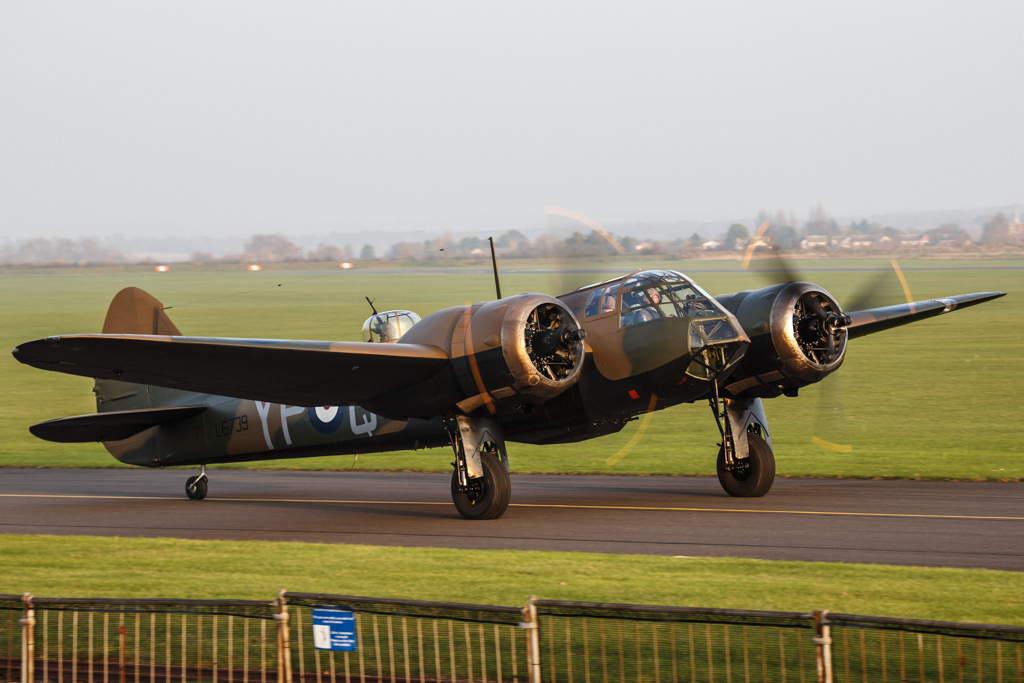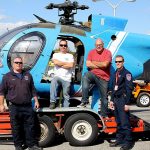
As reported on Thursday, November 20th by Global Aviation Resource, the world finally has an airworthy Bristol Blenheim again. Under the golden light of the setting sun, the Aircraft Restoration Company’s owner and chief pilot John Romain took Blenheim Mk.I L6739 up on a short first flight from his base at the former RAF Duxford near Cambridge, England. The sweet thrum of the Blenheim’s two Bristol Mercury engines echoed off the hangar walls as Romain lifted her into the sky; a rich reward following more than a decade of labor in bringing the rare bomber back to flying condition again.
This particular Blenheim is actually a hybrid airframe, incorporating the bulk of a Canadian-built Blenheim Mk.IV, more correctly referred to as a Bolingbroke, and the restored cockpit section from a British-built Blenheim Mk.I. ARCo has long been associated with the Blenheim/Bolingbroke, having restored two previous examples to flying condition over the past few decades, both based on Canadian Bolingbrokes. Sadly the first one, RCAF 10038, was lost in a bad accident during a touch-and-go landing at Denham just a month after its first flight in May, 1987. Miraculously, none of the crew was seriously hurt. Undeterred by such a major setback, ARCo restored and flew a second example, RCAF 10021, just five years later. Following ten years of successful operations, this aircraft suffered a serious landing accident at Duxford in 2003. The crew again escaped without serious injury, but the airframe wasn’t so lucky. While it appeared on the surface to be relatively undamaged, there were a lot of significant structural issues to rectify if she were ever to fly again.
During the time that RCAF 10021 was flying, ARCo had started work on restoring the cockpit section of an extinct Blenheim Mk.I. The forward fuselage from L6739, a Battle of Britain night fighter veteran, had escaped the scrappers torch only because of a wartime Bristol employee namedRalph Nelson. He had saved the component with an eye on using it to form the coachwork for an automobile he was building in his garage. The peculiar-looking car did indeed drive on the roads in postwar Britain for a time (Click HERE to see an image). ARCo had thought that they could restore the Mk.I cockpit section up to the natural production break, and perhaps swap it out for the Mk.IV cockpit at some point in 10021’s future to offer a different look to the aircraft. However, fate intervened, and with the accident, ARCo decided to rebuild the wreck of 10021 using the by-now nearly complete Mk.I cockpit section from the start.
With Thursday’s first flight, not only is there finally a Blenheim flying again, but we now have a representative, structurally complete Blenheim Mk.I for the first time since the 1940s as well. Other than a couple of cockpit sections preserved in Finland and the tattered remains of a 211 Squadron Blenheim Mk.I L1434 in Greece, there are no known significant parts from Blenheim Mk.Is surviving in preservation anywhere. In truth there is only one complete British-built Blenheim Mk.IV known to survive either, and this is also in Finland. There are also the substantially complete remains of a 203 Squadron Blenheim Mk.IVF L9044 were raised off the coast of Crete about twenty years ago, and now reside in the Hellenic Air Force Museum in Greece. Other than that though, the rest of the world’s surviving ‘Blenheims’ are actually Bolingbrokes. Many congratulations are due to ARCo and all of their tireless supporters in getting L6739 flying. Long may she continue to do so and carry the flag for the thousands of airmen who served, and often died, in this under-appreciated aircraft; vital to Britain’s early war effort against Axis forces.
WarbirdsNews wishes to thank Global Aviation Resource for allowing us to use their story and photographs here. Please see the rest of Global Aviation Resource’s story, and some further magnificent photographs from George Land and Ashley Stephenson by clicking HERE.




























